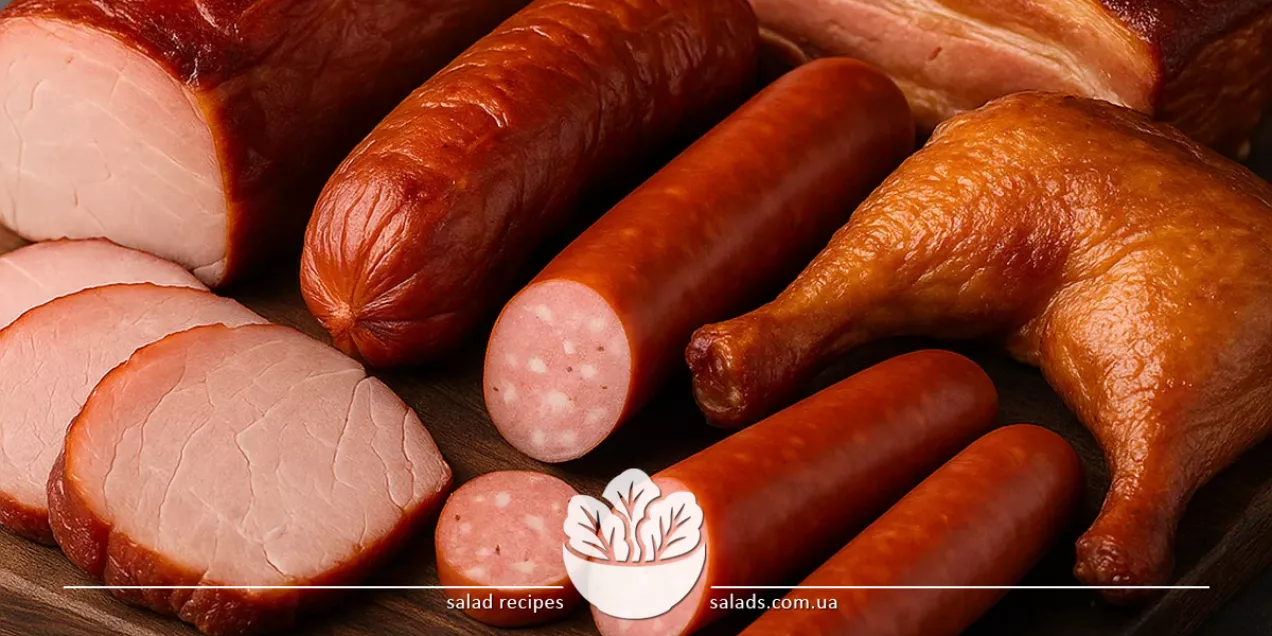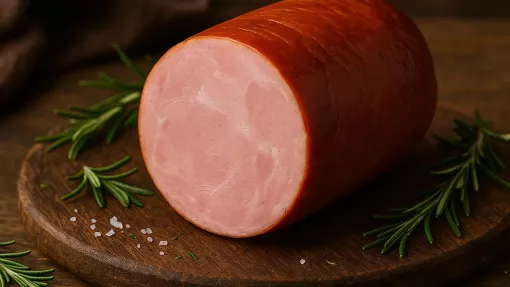Smoked Meats

Smoked meats are meat products treated with hot or cold smoke, which gives them a distinctive aroma, deep flavor, and extended shelf life. During smoking, the meat is partially dehydrated and infused with phenols and other volatile compounds from wood smoke, which act as natural preservatives. This category includes a wide variety of products: sausages, ham, neck, brisket, ribs, pork roast, bacon, and more. They are made from pork, beef, turkey, or chicken, often with added spices, salt, sometimes sugar, and herbs. Within the sausage category, smoked varieties are considered the most aromatic, flavorful, and best suited for long-term storage without refrigeration. They can be served as appetizers, added to main dishes, salads, or sandwiches, and are used in many traditional recipes.
Types of Smoked Meats and Sausages
Main Varieties and Smoking Methods
Smoked meats are classified based on the type of meat, recipe, and smoking method. The most common are smoked sausages, bacon, neck, pork roast, ham, ribs, and brisket. These are usually made from pork or beef, although options using chicken or turkey – leaner but still flavorful – are becoming increasingly popular. Smoking can be hot or cold. Hot smoking occurs at 70-100 °C and produces a ready-to-eat product with a soft, juicy texture. This method is commonly used for sausages, neck, and pork roast. Cold smoking is done at temperatures up to 30 °C and takes significantly longer – anywhere from several days to several weeks. This technique allows the meat to absorb the smoke aroma more fully, dry out, and retain a firm texture. The result is refined smoked meats with a bold flavor and long shelf life.
Classic examples include salami-style sausages, which are cold-smoked and aged. Also popular are products made from pork neck or shoulder, known for their even marbling and well-balanced aroma after smoking. These pair well with sides such as rye bread, mustard, or pickled vegetables. Bacon, made from pork belly, has a delicate texture and balanced flavor. It is used in both hot dishes (like fried eggs or sandwiches) and in appetizers, rolls, tarts, or even salads. Ham usually undergoes both smoking and extended aging, which gives it a refined structure and complex bouquet of aromas. Properly smoked meats don’t require cooking – just slice and serve. This makes them ideal for charcuterie boards, canapés, quick snacks, or travel food.
Composition, Calories, and Nutritional Value
Smoked meats are a concentrated source of protein, animal fat, and micronutrients preserved through a special smoking process. High-quality products are made from whole cuts of meat, sometimes with added salt, spices, natural sugar, or herbs. Most traditional recipes avoid synthetic preservatives, as the smoking process itself inhibits bacterial and fungal growth. Caloric content ranges from 250 to 450 kcal per 100 g, depending on the meat type, fat content, and processing method. For example, fatty cuts like neck and brisket are more calorie-dense, while smoked turkey or ham from tenderloin are lower in calories. Protein content also varies: salami-style sausages or prosciutto may contain 20–25% protein.
Nutritionally, smoked meats are rich in B vitamins (especially B1, B6, and B12), iron, phosphorus, sodium, and zinc. These nutrients are essential for energy metabolism, nervous system function, and immune support. However, due to high salt content (often more than 2 g per 100 g), smoked meats should be eaten in moderation – especially by those with hypertension or kidney issues. Industrial smoked meats may contain nitrites or smoke flavorings for stable color and taste. While regulated, it’s best to choose products labeled “naturally smoked” or “without preservatives.” For example, hams smoked over beechwood or fruitwood chips. Smoked meats pair well with many dishes, forming a balanced meal. For instance, smoked neck with cooked tomatoes and rye toast makes for a hearty breakfast rich in protein and easy to digest.
Culinary Uses of Smoked Meats
Smoked meats offer wide-ranging culinary uses – they’re equally suitable for everyday meals and festive dishes. The simplest use is serving them sliced: thin pieces of ham, pork roast, or sausage with vegetables, bread, or cheese make the perfect appetizer. Thanks to their intense flavor, they require no further preparation and maintain texture well at room temperature. Smoked meats are often used in salads, particularly warm ones – with sautéed vegetables, grains, or eggs. For example, a salad with smoked brisket, arugula, boiled chicken eggs, and whole-grain mustard creates a harmonious balance of protein, fat, and spice. These dishes are filling without being heavy on the stomach.
Smoked meats are widely used in soups – especially pea, bean, or cabbage-based. They add depth to broth, boost nutrition, and contribute a unique aroma that’s hard to achieve with fresh meat. Importantly, they don’t need long cooking – just add them near the end to preserve texture. Other popular uses include casseroles, pies, or savory rolls with smoked fillings. Thinly sliced meat with spices and vegetables can be wrapped in dough or flatbread, topped with cheese, and baked. Smoked meats also serve as a base for meat sauces, canapés, and grain-based side dishes. As appetizers, they pair well with mustard, horseradish, pickled vegetables, or spicy sauces. Because of their bold flavor, even a small portion adds character to an entire recipe.
How to Choose and Store Smoked Meats
The quality of smoked meats depends on the raw ingredients, smoking method, and adherence to production standards. First, check the label: it should indicate the product is made from whole cuts of meat without mechanically separated meat, excessive flavor enhancers, colorants, or stabilizers. Ideally, the smoking process was natural, not using liquid smoke. The exterior should have a uniform golden-brown hue – too dark or unnaturally bright may suggest artificial colorants or improper smoking. The aroma should be natural and smoky, with no sour or chemical notes. The texture should be firm and elastic, without stickiness or excess moisture.
When buying, opt for vacuum-sealed or modified-atmosphere packaging, which extends shelf life without compromising taste. After opening, smoked meats should be refrigerated for no more than 3-5 days, ideally in an airtight container or wrapped in meat paper to prevent oxidation and drying. Freezing is acceptable but should be infrequent – thawed meats lose some texture and aroma. It’s better to buy in small portions or choose smaller vacuum packs. To enjoy their full flavor, serve smoked meats at room temperature – this enhances the aroma. They pair well with mustard or fruit sauces, pickled vegetables, and ingredients like pork, especially in dishes where components complement rather than compete.
Smoked Meats in the Diet: Benefits, Risks, and Pairings
Smoked meats aren’t just a treat for gourmets – they’re also a complete protein source that can enrich a balanced diet if consumed in moderation. Thanks to their concentrated makeup, smoked meats supply energy, amino acids, and micronutrients while retaining nutritional value after processing. However, moderation is key: high salt and fat content, plus potential nitrite residues, limit daily intake. Smoked meats should be part of a diverse diet, not a daily staple. It’s best to enjoy them 1-2 times a week, paired with vegetables, fresh bread, and protein-rich sides.
Great combinations include platters with smoked ham or brisket and cabbage, beans, or rye toast. In festive meals, smoked meats are often added to salads, rolls, or appetizers as a bold accent. They can be paired with sweet or sweet-and-sour sauces – berry-based, mustard, or honey. Smoked meats are also a convenient alternative to other protein sources when cooking isn’t an option – during travel, hiking, or quick snacks. Paired with salt or herbs, smoked meat has a strong, lasting flavor that requires no additional seasoning. Ultimately, smoked meats are not just a product – they represent an entire culinary culture. Whether part of your daily meals or a festive spread, the key is to choose wisely, combine thoughtfully, and enjoy in moderation.
